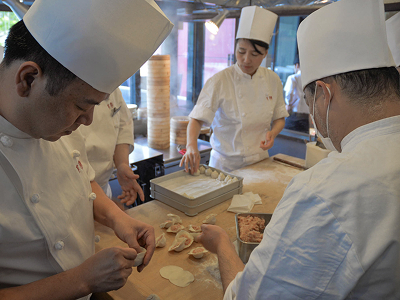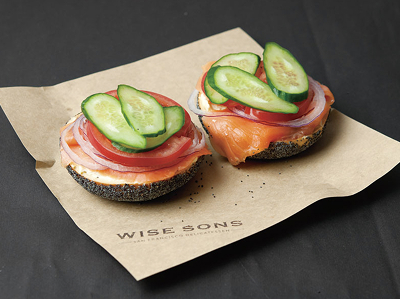More Work

Look at the Tiny Tourists and Bite Size Burglars of Japan’s Mini World
PUBLICTION
Atlas Obscura
SNIPPET
In a country where highly detailed, unapologetically kitsch attractions reign supreme, Tobu World Square takes the cake.
Nestled among the idyllic mountain surroundings of Nikko, around two hours north of Tokyo, Tobu World Square is an architectural park with 102 1:25 scale replicas of famous landmarks from around the world. The replicas, which took five years to complete, were built by the people of Toho Eizo Bijutsu, a Japanese film production company renowned for designing the sets of the early Godzilla films.
Scattered around the landmarks are 140,000 people, each about three inches tall, each involved in some sort of intriguing scene.

The rising star of Tokyo’s dim sum scene
PUBLICATION
The Japan Times
SNIPPET
There’s a long-standing rift in my family over how soup gets inside xiao long bao dumplings. The popular school of thought is that chefs freeze the liquid into cubes and parcel them up into the flour-based skin before steaming.
A more radical faction maintains that the soup is carefully injected into the pre-assembled teardrop dumpling with a syringe after cooking.
How painfully wrong we all were.

Staff Meal:
Sunda
PUBLICTION
Broadsheet
SNIPPET
Walking into Sunda at 4pm is like stumbling upon an orchestra setting up for a performance. Chefs quietly prep in the kitchen. Out in the dining section, front-of- house staff set up tables and fold napkins. Restaurant manager Kosta Kalogiannis paces, silently figuring things out in his head.
By 4.10pm the energy has picked up notably. Cutting through the sparse atmosphere, chef de par- tie Nabil Ansari yells: “Hot wok coming through!” He passes head chef Khanh Nguyen, who’s slapped on a pair of latex gloves and is coating a couple of trays of chicken wings in curry paste, chickpea flour and desiccated coconut. On the other side of the kitchen, chef de partie Lauren See is squeezing small dollops of honey out onto a tray of carrots, which are sliced thick and are slightly charred.
Before long, the last of the serenity is eclipsed by a commanding sizzling sound when Nguyen drops a batch of the chicken into a deep fryer. An intoxicating aroma follows; the symphony has begun. This is a typical afternoon at Sunda, Adipoetra Halim’s Southeast Asian restaurant, which opened on Punch Lane last year. Chefs take turns leading the off-menu staff dinners, which often involve special ingredients and begin at 4.30pm when, per Nguyen’s insistence, everyone sits down together. “We make sure they get well fed,” says Nguyen.

Tradition finds a home on Tokyo’s bagel scene
PUBLICATION
The Japan Times
SNIPPET
At a glance, Wise Sons Tokyo is a strange addition to the subterranean fringes of Tokyo Station. But zoom in on this Jewish delicatessen and you’ll find something warm and inviting: crooked family photographs hanging on the wall, deli-style padded benches, bright timber features and, most importantly, row upon glorious row of bagels.
Co-owner Evan Bloom, who runs nine other Wise Sons in and around San Francisco with his brother Ari, says that opening a Tokyo outpost was a “little, wacky dream” for him.
“Bagels in Japan are a very Japanese product,” he said during a recent visit to Tokyo. “For one, bread tends to be much softer and lighter (in Japan). Sweeter, too. And there are a lot of different flavors. Essentially, it can be shaped like a bagel, but that’s kind of the only relation.”

A Jewel Hidden in the Foothills of the Otway Ranges
PUBLICTION
Broadsheet
SNIPPET
There’s a weathered “DIAL 000” emergency sign by the side of the road as you drive into Forrest. A tiny, laidback town, population 170, it’s hidden in the expansive foothills of the Otway Ranges, far from Melbourne two hours away. As well as a pub, cafe, general store and restaurant-microbrewery, Forrest is home to one of the area’s consummate gastronomical wonders, Bespoke Harvest.
The restaurant has gained a quasi-cult following over the last couple of years. Emma and Peter Ashton, who also run the Forrest Guesthouse in the same building, brought on chef Simon Stewart in 2014 to run what was then a cafe. Stewart, who previously worked in kitchens including the now-closed – but once celebrated – Torquay Middle Eastern tapas restaurant Scorched, was taking a break from cooking at the time after the arrival of his second child, and was managing a pet food store in Colac. The timing was right to get back in the game.

Seaweed as Food:
An Explainer
PUBLICATION
Broadsheet
SNIPPET
Seaweed. How much do you actually know about brown, green or red algae? Where can you find it? Which chefs are using it, and who’s actually using it differently?
As a food source, seaweed – which is actually a misnomer because you can find it in most bodies of water – is most commonly used in Chinese, Korean and Japanese cooking. The Japanese have been eating keiso (seaweed) for at least 1500 years , and mass producing nori (those lustrous dark-green roasted sheets) since the Edo period (1603 to 1868), when they’d harvest the red algae from Tokyo Bay and dry it over bamboo mats like paper. Today commercial seaweed is an industry worth more than US$6 billion annually.
And it’s very good for you. According to Dr Alecia Bellgrove from Deakin University it’s a rich source of vitamin B12 and omega-3 fatty acids. It also contains a lot of dietary minerals that are often “lacking in Australian vegetables,” she says, such as iodine, iron and zinc. Benefits are reportedly far-ranging: it’s said to reduce the risk of obesity, may help manage diabetes and has potential in reducing the risk and effects of Alzheimer’s.
